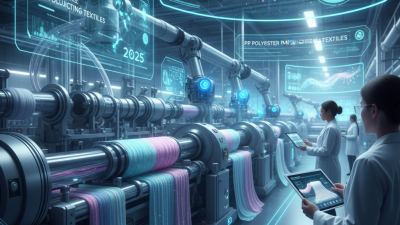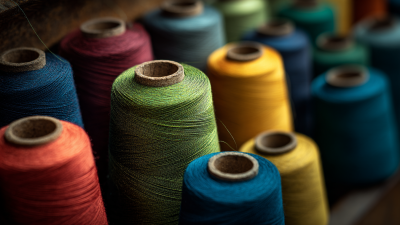- +86 13957580925
- 510515850@qq.com
- adela0928@163.com
In recent years, the textile industry has witnessed a transformative wave of innovations, particularly in the realm of Pp Polyester. As we approach the advancements of 2025, experts are focusing on how these developments will redefine fabric production and sustainability. Renowned Pp Polyester expert Dr. Emily Zhang emphasizes the importance of these innovations by stating,
"The future of textiles lies in maximizing the efficiency and sustainability of Pp Polyester, which will revolutionize the industry's approach to both production and environmental responsibility."

The integration of cutting-edge technology, such as advanced recycling processes and eco-friendly manufacturing techniques, is set to elevate Pp Polyester to new heights. This evolution not only promises enhanced performance characteristics—such as durability and moisture-wicking properties—but also aligns with global sustainability goals. As we delve deeper into 2025's top five Pp Polyester innovations, we will explore how these advancements are not only changing the textile landscape but also meeting the growing consumer demand for sustainable and high-performing materials.
These innovations reflect a larger trend within the textile industry towards a more circular economy, where waste is minimized and resources are utilized more effectively. By examining these key developments, we can appreciate how Pp Polyester will play a pivotal role in the future of textiles. As we prepare for the upcoming changes, the focus remains on marrying performance with responsibility, creating fabrics that are not just functional, but also conscious of their environmental impact.
In recent years, the textile industry has witnessed a significant transformation propelled by innovative fiber blends, particularly in polypropylene (PP) polyester. These advancements focus on enhancing both performance and sustainability, addressing the growing consumer demand for environmentally friendly yet high-performance fabrics. By merging conventional PP polyester with other sustainable materials, manufacturers are creating textiles that not only boast improved durability and functionality but also reduce environmental impact, marking a pivotal shift in textile production.
One standout development is the incorporation of bio-based fibers into PP polyester blends. This combination not only leverages the lightweight and moisture-wicking properties of synthetic fibers but also introduces renewable resources that lower the overall carbon footprint of the textiles. Additionally, innovations like enhanced dyeing processes minimize water usage and energy consumption, further supporting sustainable practices within the industry. As these revolutionary fiber blends continue to evolve, they pave the way for a new era of textiles that are both high-performing and eco-conscious, setting new benchmarks for what consumers can expect from their clothing and upholstery.
| Innovation | Description | Performance Benefits | Sustainability Features | Market Impact |
|---|---|---|---|---|
| Recycled Pp Polyester Blends | Innovative blends utilizing recycled materials to enhance eco-friendliness. | Improved durability and tensile strength. | Reduced carbon footprint and energy consumption. | Increased demand in eco-conscious markets. |
| High-Performance Moisture-Wicking Fibers | Fibers designed to wick moisture away from the body for improved comfort. | Enhanced breathability and comfort in activewear. | Utilization of sustainable production processes. | Growth in the sports apparel sector. |
| Bio-Based Polyester Blends | Blends made partially with bio-based materials.” | Lightweight with enhanced stretchability. | Minimizes reliance on petrochemicals. | Attractive for consumers seeking green alternatives. |
| Smart Textiles | Integration of technology for temperature regulation and health monitoring. | Improved user comfort and functionality. | Developed with sustainable materials and production methods. | Rising popularity in both active and lifestyle apparel markets. |
| Antimicrobial Fibers | Fibers that inhibit bacterial growth for longer-lasting fresh textiles. | Extended product lifespan and reduced odor. | Eco-friendly treatments that reduce chemical spills. | Increasing adoption in hygiene-focused applications. |
The integration of technology into textiles, particularly through innovative Pp polyester solutions, is reshaping the apparel industry. As of 2023, the global smart textiles market is projected to reach approximately $4.7 billion, with a compound annual growth rate (CAGR) of 24.4% from 2021 to 2028, according to a report by Grand View Research. This staggering growth is indicative of an increasing demand for textiles that not only provide comfort but also offer enhanced functionality. This is being achieved through the application of conductive fibers, sensors, and other electronic components that allow garments to respond to their environment and the needs of wearers.
One notable advancement is the development of fabrics that can monitor vital signs, such as heart rate and body temperature, in real-time. Companies are leveraging Pp polyester’s lightweight and durability characteristics to create wearables that seamlessly integrate into daily life. Additionally, smart textiles are being designed for specialized applications, including sports and healthcare, enhancing performance while providing valuable data for users. As the industry moves forward, the synergy between Pp polyester innovations and smart technology will play a crucial role in meeting consumer demands for multifunctional apparel that combines style with enhanced interactivity and monitoring capabilities.
The textile industry is witnessing a transformative shift towards sustainability, with bio-based innovations playing a crucial role in the production of polypropylene (PP) polyester. Traditional PP polyester, while versatile and widely used, comes with significant environmental concerns, primarily due to its reliance on fossil fuels and the challenges associated with its disposal. However, advancements in bio-based materials are paving the way for more eco-friendly alternatives that not only address these issues but also maintain the performance characteristics desired in textiles.
Recent breakthroughs involve the use of renewable resources, such as plant-based feedstocks, for producing PP polyester. These bio-based polymers significantly reduce the carbon footprint associated with textile manufacturing and offer enhanced biodegradability compared to their petroleum-based counterparts. Companies are now investing in innovative technologies that convert agricultural waste into viable bio-based PP polyester, thus promoting a circular economy within the textile sector. This shift not only improves sustainability but also enhances brand reputation as consumers increasingly favor environmentally responsible products in their purchasing decisions.
Advanced recycling techniques are revolutionizing the textile industry by significantly reducing waste and promoting a circular economy. Traditional textile manufacturing often leads to substantial environmental challenges, including excessive waste and the depletion of natural resources. However, innovative recycling processes are beginning to change this narrative. Techniques such as chemical recycling and mechanical recycling enable the transformation of post-consumer polyester products back into high-quality raw materials, minimizing the need for virgin resources and reducing landfill contributions.
These advancements not only foster sustainability but also enhance the overall efficiency of the textile supply chain. Companies are increasingly adopting closed-loop systems, where old garments are collected, recycled, and converted into new textiles, thereby extending the lifecycle of materials. Additionally, these methods can contribute to the economic viability of the textile industry, providing cost-effective alternatives to traditional production while appealing to environmentally-conscious consumers. As the demand for sustainable fashion increases, these innovative recycling techniques are poised to play a critical role in shaping a more responsible and circular textile economy.
The textile industry has witnessed remarkable innovations in the development of Pp polyester, particularly through the advancements in functional coatings. These coatings are engineered to significantly enhance the durability and comfort of polyester fabrics, making them more appealing for both consumers and manufacturers. According to a recent report by Smithers Pira, the global textile coatings market is projected to reach $5 billion by 2025, driven by the growing need for multifunctional textiles that provide enhanced protection against environmental factors.
Functional coatings can imbue polyester fabrics with a range of desirable properties, such as water resistance, UV protection, and antimicrobial benefits. For instance, studies have shown that adding specific polymeric coatings can increase the fabric's durability by over 30%, prolonging the life of garments and reducing waste in the long run. Furthermore, these advancements in coatings are essential for improving comfort; polyester fabrics treated with breathable coatings can enhance moisture-wicking capabilities, allowing for better airflow and keeping wearers dry and comfortable during various activities. This dual focus on durability and comfort positions functional coatings at the forefront of textile innovation, shaping the future landscape of the industry.
This chart illustrates the advancements in functional coatings technology that enhance the durability and comfort of polyester fabrics. The data represents the impact of various innovations on both durability and comfort ratings as reported by textile researchers.






